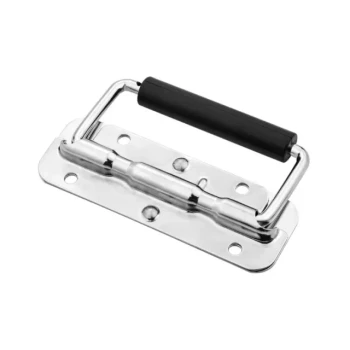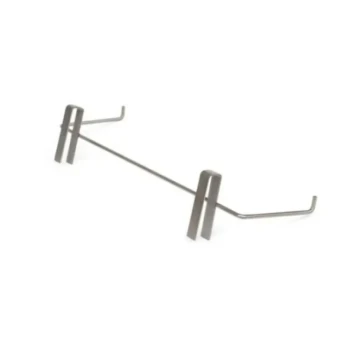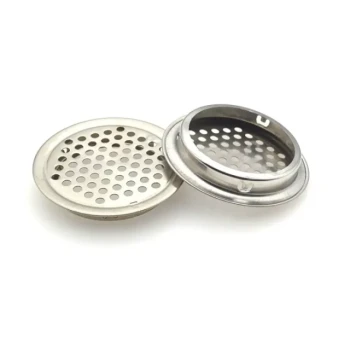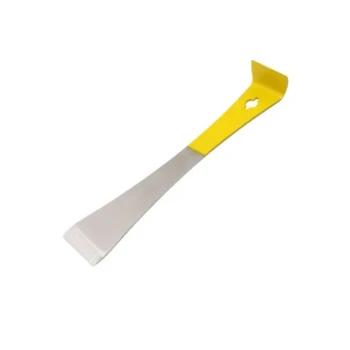At its core, a garden hive lid is designed to fit snugly over the top box of your beehive. This component consists of two main parts: a flat inner cover that sits directly on the hive body and a larger, telescoping outer cover that fits over it. The outer cover overhangs the sides of the hive, creating a protective seal against weather and pests while the inner cover provides crucial insulation and ventilation.
The fit of a hive lid is more than just a simple cover. It is a critical component of the hive's environmental control system, directly impacting temperature regulation, moisture management, and the colony's defense against outside threats.
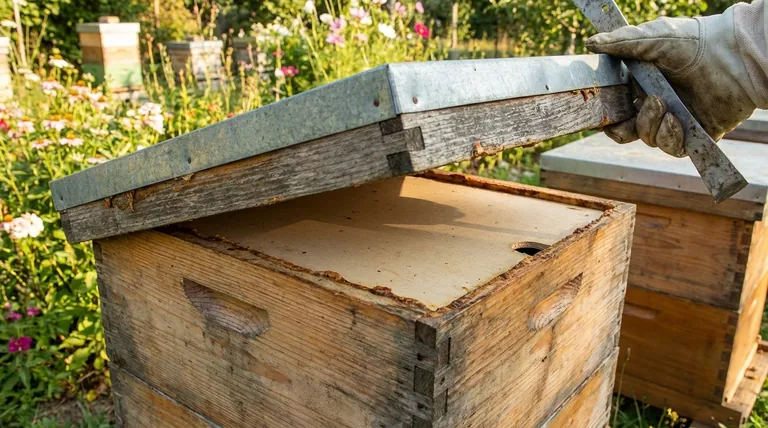
The Anatomy of a Proper Lid Fit
Understanding how the components work together is key to appreciating their function. A standard "garden hive" or Langstroth hive lid is a two-part system designed for maximum protection and utility.
The Role of the Inner Cover
The inner cover is the first layer. It's a flat wooden board, often with a rim, that sits directly on the uppermost hive box (either a honey super or brood chamber).
This piece serves several purposes. It creates a dead air space between itself and the outer cover, which provides excellent insulation. It also typically has a small notch or hole, which can serve as an upper entrance for the bees and a critical vent for moist air.
Finally, the inner cover prevents the bees from gluing the outer lid directly to the hive frames with propolis (a resinous "bee glue"), making inspections far easier.
The Telescoping Outer Cover
The telescoping outer cover is what most people picture as the hive "roof." It is designed to fit over the inner cover and hang down—or "telescope"—over the top edges of the hive box by an inch or more.
This overhang is the hive's primary defense against the elements. It prevents rain from driving into the top of the hive and makes it much more difficult for pests like ants to find a way inside. Most modern telescoping covers are made of wood and sheathed in a protective layer of aluminum.
Ensuring a "Snug" but Not Airtight Seal
The goal is a snug fit, not an airtight one. The lid should sit securely without significant gaps that would allow rain or pests to enter easily.
However, the hive must breathe. The notch in the inner cover and any slight imperfections in the fit are essential for allowing excess moisture and heat to escape, preventing dangerous condensation inside the hive, especially during winter.
Why the Fit is Critical for Hive Health
A poorly fitting lid can quickly lead to a struggling or lost colony. The design is a deliberate solution to several environmental challenges bees face.
Moisture Control and Ventilation
A colony of bees releases a tremendous amount of water vapor through respiration. In a cold climate, this warm, moist air rises. If it hits a cold, sealed surface, it will condense and drip back down onto the bees, which can be fatal.
A proper lid setup with an inner cover allows this moisture to either vent out the top notch or condense harmlessly on the underside of the inner cover, away from the bees.
Temperature Regulation
The air gap created between the inner and outer covers is a simple yet brilliant form of insulation. It helps the colony stay cooler in the hot summer sun and, more importantly, retain its own generated heat during the cold of winter.
Protection from Pests and Robbers
A loose, warped, or damaged lid is an open invitation. Pests like ants, wax moths, and small hive beetles can exploit gaps to gain entry.
Furthermore, a weak colony with a poorly fitting lid can be a target for robbing bees from stronger nearby hives, who will steal all their honey stores, dooming the colony.
Understanding the Trade-offs and Common Issues
Even with a perfect design, there are practical challenges to be aware of when managing hive lids.
The Problem of a Warped Lid
Wooden hive equipment can swell and warp with exposure to moisture and temperature changes. A warped lid will not sit flat, creating gaps that compromise the hive's security and weather resistance. Applying a good coat of exterior paint to all wooden parts is crucial for longevity.
The "Stuck" Lid Dilemma
Bees are masters of sealing cracks. They will use propolis to glue the inner cover to the hive box and the outer cover to the inner cover. This is a sign of a healthy, industrious colony and a good fit.
This means you will almost always need a hive tool—a small, specialized crowbar—to pry the covers apart during an inspection. A lid that lifts off with no resistance is a red flag that it is not fitted correctly.
Forgoing the Inner Cover
Some beekeepers, particularly those who move hives frequently (migratory beekeepers), use a simple flat lid with no inner cover. While this simplifies inspections, it sacrifices the critical benefits of insulation and moisture management provided by the two-part system.
Making the Right Choice for Your Goal
The best lid configuration depends on your climate, beekeeping goals, and management style.
- If your primary focus is maximum weather protection: Always use a standard telescoping outer cover combined with an inner cover for the best insulation, moisture management, and security.
- If your primary focus is ventilation in hot climates: Use a standard lid setup but ensure the inner cover notch is open, and consider a screened inner cover or a lid with built-in ventilation ports.
- If your primary focus is a natural, top-bar, or Warre hive: These hives have their own specific lid designs, but the principles of weather protection, ventilation, and a non-hermetic seal remain the same.
A properly fitted lid is one of the most important investments you can make in the long-term health and stability of your colony.
Summary Table:
| Lid Component | Key Function | Impact on Hive Health |
|---|---|---|
| Inner Cover | Creates insulation, provides upper entrance/vent, prevents propolis bonding | Manages temperature & moisture; facilitates inspections |
| Telescoping Outer Cover | Overhangs hive box to block rain and pests | Primary defense against weather and intruders |
| Overall Fit | Snug but not airtight seal | Balances protection with essential hive ventilation |
Protect your investment and ensure your colonies thrive with the right equipment. A properly fitted hive lid is fundamental to successful beekeeping. HONESTBEE supplies durable, precision-crafted beekeeping supplies and equipment—including inner covers and telescoping lids—to commercial apiaries and beekeeping equipment distributors through our wholesale-focused operations. Let us help you equip your hives for maximum health and productivity. Contact our expert team today to discuss your wholesale needs.
Visual Guide
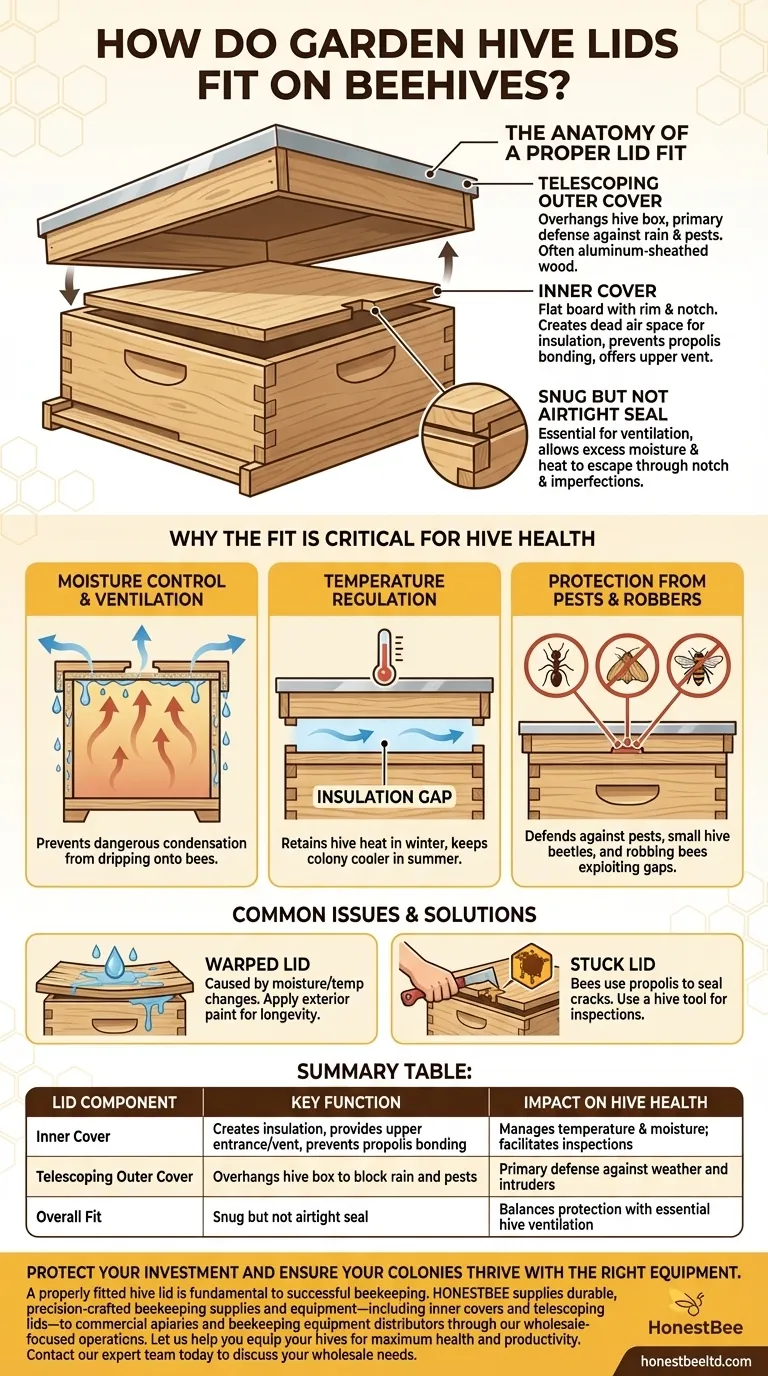
Related Products
- Professional Insulated Winter Hive Wrap for Beekeeping
- Long Langstroth Style Horizontal Top Bar Hive for Wholesale
- Professional Galvanized Hive Strap with Secure Locking Buckle for Beekeeping
- Inner Beehive Cover for Beekeeping Bee Hive Inner Cover
- Premium Comfort Grip Spring-Loaded Hive Handles
People Also Ask
- Should bee hives be insulated? Protect Your Colony from Moisture, Not Just Cold
- What are the benefits of insulated beehives in cold weather? Boost Winter Survival & Spring Productivity
- How does insulation help bee hives in severely cold weather? Conserve Energy & Ensure Colony Survival
- Why is it important to insulate beehives during winter? Boost Your Colony's Survival Rate
- What are the durability features of Bee Blankets? Built to Last in Demanding Apiary Conditions




